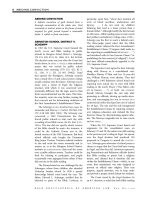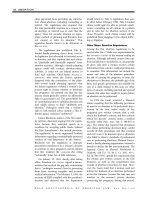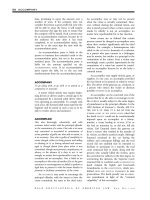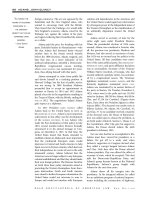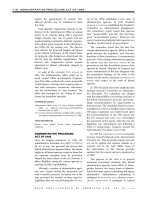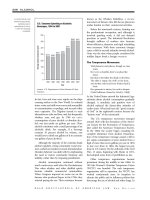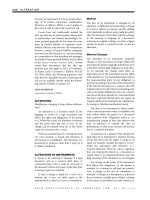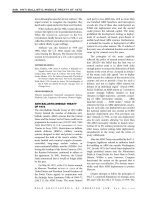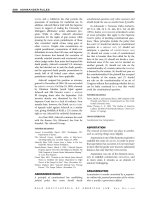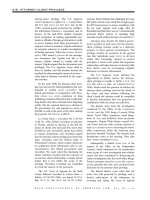Gale Encyclopedia Of American Law 3Rd Edition Volume 4 P4 ppsx
Bạn đang xem bản rút gọn của tài liệu. Xem và tải ngay bản đầy đủ của tài liệu tại đây (237.73 KB, 10 trang )
A draft may be payable to a designated payee
or to the bearer—the person who has posses-
sion of the draft at the time it is presented to the
drawee for payment—pursuant to the drawer’s
directions.
A draft is sometimes synonymous with a
BILL OF EXCHANGE, COMMERCIAL PAPER,orNEGOTIA-
BLE INSTRUMENT
.
DRAFTER
The person who draws or frames a legal document
such as a will, pleading, conveyance, or contract.
One who writes an original legislative bill for the
U.S. Senate or House of Representatives is called
the drafter of that bill.
DRAIN
A trench or ditch to convey water from wet land; a
channel through which water may flow off. The
word has no technical legal meaning. Any hollow
space in the ground, natural or artificial, where
water is collected and passes off, is a ditch or
drain.
Also, sometimes, the easement or servitude
(acquired by grant or prescription) that consists of
the right to drain water through another’s land.
A number of states have drainage statutes in
order to protect the welfare of the public. Such
statutes provide for the construction of drains
in areas that are swampy, marshy, or overflowed
past their natural boundaries. Also contained in
drainage statutes are provisions that regulate the
creation and organization of drainage districts.
The state legislature has the discretion to decide
which lands will be included within a particular
drainage district. For example, such a district
might include territory of a city or village or
property in two or more counties.
The specific plan for the construction of a
drain is within the discretion of local auth orities
as modified by limitations or restr ictions set
forth by state drainage statutes. Only land that
will be benefited through drainage improve-
ments shou ld properly be included within a
drainage district.
In certain instances, liability has been
extended to drainage districts that have failed
to maint ain existing drains. In order to remedy
this situation, in some cases, landowne rs are
given a certain portion of a drain to clean out
and maintain in proper repair. Regardless of
whether or not a landowner is specifically given
the responsibility for maintenance, a landowner
may only close or obstruct a drain with his or
her neighbors’ consent. If the land of an indivi-
dual is injured because a public drain is being
obstructed by a neighbor, then the person can
BRING SUIT for the damage resulting therefrom.
Subject to limitations imposed by the U.S.
Constitution, a state legislature has the power to
authorize drainage districts to prescribe special
assessments to cover the cost of drainage
improvements. Generally, only those lands inclu
ded within a particular district are subject to such
assessment. In certain states, school lands are
exempted from assessments that drainage dis-
tricts levy. Assessment review boards frequently
entertain objections to drainage assessments;
however, if no such board exists, assessments
are subject to judicial reviews in the courts. A
property owner can, therefore, go to court to
challenge what he or she believes to be an unjust
drainage assessment against his or her land.
DRAMSHOP ACTS
Statutes, also called civil liability acts, that impose
civil liability upon one who sells intoxicating
liquors when a third party has been injured as a
result of the purchaser’s intoxication and such
sale has either caused or contributed to the state of
intoxication.
A dramshop is any type of drinking establish-
ment where liquor is sold for consumption on the
premises, such as a bar, a saloon, or, in some cases,
a restaurant. Under
DRAMSHOP ACTS, the seller of
liquor can be sued by an individual who is injured
by an intoxicated person. Such acts protect the
injured
THIRD PARTY not only against personal
injuries and property damages resulting directly
from the actions of the intoxicated individual
(such as those resulting from drunken driving or
ASSAULT AND BATTERY) but also against the loss of
family support owing to such injuries. Generally,
the person who became intoxicated cannot sue the
seller if she or he is injured, nor can any active
participant in the drinking.
The dramshop laws are based on the principle
that anyone who profits from the sale of alcoholic
beverages should be held liable for any resulting
damages. For a seller to be held liable, it is
unnecessary to show that he or she is negligent,
provided it is proved that the seller sold liquor to a
habitual drunkard or a person who was already
drunk, which is generally illegal in itself.
GALE ENCYCLOPEDIA OF AMERICAN LAW, 3RD E DITION
18 DRAFTER
Dramshop acts originated in the TEMPERANCE
MOVEMENT
of the mid-1800s. In Illinois, for
example, the first such law was passed in 1872
and amended in subsequent decades. By the
1990s more than 40 states had either dram-
shop acts or court rulings that made a com-
mercial server or seller of alcohol liable if an
intoxicated customer caused an accident or
injury upon leaving the server’s or seller’s
establishment (e.g., the Iowa Alcoholic Beverage
Control Act [Iowa Code Ann. § 123.92 (West)]).
Typical modern statutes include limitations on
awards, specifications regarding the commercial
defendant’s type and degree of liability, and a
STATUTE OF LIMITATIONS.
By the late 1980s, dramshop statutes and
court rulings had caused a dramatic increase in
lawsuits involving liquor liability, with a corre-
sponding increase in damage awards to victims.
As a result, liquor liability in surance became
increasingly expensive and difficult to obtain.
To guard against costly dramshop suits,
liquor vendors have taken a variety of steps to
prevent negligent behavior: eliminating “happy
hours,” reducing late-night operation, offering
free Breathalyzer tests, instituting designated-
driver programs, and training servers on how to
deal with intoxicated patrons. Several states
have made precautions such as these mandatory.
Some, such as Oklahoma, have banned happy
hours (see 37 Okla. Stat. Ann. § 537 [West]);
others have required server training. Many
insurance companies either require such preven-
tive measures or offer incentives for their use.
Many states have extended dramshop liability
to corporate or individual social hosts who
provide alcoholic beverages without charge. This
new source of liability has produced an extraordi-
nary number of lawsuits. Accordingly, individuals
wishing to host a social orbusiness function in one
of these states would now be required to take
many of the same precautions commercial
establishments do, including obtaining liquor
liability insurance, or else they would have to
hold their gathering at an insured bar or hotel.
FURTHER READINGS
Allen, Jeffrey Wynn. 1994. “Illinois Dram Shop Reform.”
John Marshall Law Review 28 (fall).
Fancher, Catherine. 1993. “One Too Many? … Dram Shop
Act….” Texas Tech Law Review 25.
Smith, Jacob D. 2002. “Rethinking a Broker’s Legal
Obligations to its Customers—The Dramshop Cases.”
Securities Regulation Law Journal 30, no. 1 (spring).
Smith, Richard. 2000. “A Comparative Analysis of Dram-
shop Liability and a Proposal for Uniform Legislation.”
The Journal of Corporation Law 25 (spring).
Weiss, Ann E. 1987. The Supreme Court. Berkeley Heights,
N.J.: Enslow.
DRAW
To aim a firearm, or deadly weapon, at a
particular target.
To prepare a written bill of exchange,
COMMERCIAL PAPER, draft, or negotiable instrument
and place one’s signature on it, creating a legal
obligation under its terms. To write a document,
such as a deed, complaint, or petition, including
the essential information necessary to make it
legally effective upon its execution by the
designated parties.
To lawfully remove money from an account
held in a bank, treasury, or other depository.
DRAWEE
A person or bank that is ordered by its depositor, a
drawer, to withdraw money from an account to
pay a designated sum to a person according to
the terms of a check or a draft.
CROSS REFERENCE
Commercial Paper.
ALCOHOL-RELATED TRAFFIC FATALITIES, 1990 TO 2007
Percentage of traffic fatalities involving
alcohol-impaired driver or nonoccupant
0
10
20
30
40
50
1990
2000
2007
1995
60
Year
.01 to .07 BAC
a
.08 or over BAC
a
a
BAC stands for blood alcohol concentration.
50.7
42.5
41.5
38.0
6.7
6.0
6.0
6.0
44.0
36.5
35.5
32.0
Dramshop Acts
SOURCE: U.S. National Highway Traffic Safety
Administration, Traffic Safety Facts, annual.
ILLUSTRATION BY GGS
CREATIVE RESOURCES.
REPRODUCED BY PER-
MISSION OF GALE, A PART
OF CENGAGE LEARNING.
GALE ENCYCLOPEDIA OF AMERICAN LAW, 3
RD E DITION
DRAWEE 19
DRAWER
A person who orders a bank to withdraw money
from an account to pay a designated person a
specific sum according to the term of a bill, a check,
or a draft. An individual who writes and signs a
commercial paper, thereby becoming obligated
under its terms.
DRED SCOTT V. SANDFORD
In Dred Scott v. Sandford, 60 U.S. (19 How.)
393, 15 L. Ed. 691 (1857), the U.S. Supreme
Court faced the divisive issue of
SLAVERY. Chief
Justice ROGER B. TANEY, a former slaveholder,
authored the Court’s opinion, holding that the
U.S. Constitution permitted the unrestricted
ownership of black slaves by white U.S. citizens.
In a stunning 7–2 decision, the Court declared
that slaves and emancipated blacks could not
be full U.S. citizens. Any attempt by Congress
to limit the spread of slavery in U.S. territories
was held to be a direc t violation of slave owners’
due process rights.
Chief Justice Taney’s opinion fueled the
nineteenth-century abolitionist movement and
helped push the United States toward civil
war. Although Taney was an accomplished
jurist who served as chief justice for 29 years,
his record was permanently tarnished by what
many considered to be his flawed reasoning in
the Dred Scott case.
African slavery was introduced in the
American colonies in 1619. As the new country
grew, slavery spread throughout the South,
where cheap labor was needed for harvesting
large cotton and tobacco crops. During the
early nineteenth century, opponents of slavery
began to organize in the North.
Abolitionists initially wanted to restrict
slavery to the south ern states, but their ultimate
goal was to outlaw black servitude throughout
the United States. As new territories from the
LOUISIANA PURCHASE applied for U.S. statehood,
the issue became a sticking point. Most south-
erners supported the spread of slavery, viewing
it as a necessary condition for their social,
political, and economic survival. Most north-
erners favored the containment and eventual
eradication of slavery. Although political mod-
erates called for voters in each new territory to
resolve the slavery issue, a national consensus
on this point was never reached.
The 1820 Missouri Compromise was an
attempt by the U.S. Congress to balance the
competing viewpoints. Congress passed a law
designating as free states any new states located
north of a line drawn across the Louisiana
Purchase. New states south of the line would be
slave states. In other words, slavery was out-
lawed north of Missouri’s border and west to
the Rocky Mountains. After the passage of the
Missouri Compromise, two new states were
admitted: Missouri, where slavery was permit-
ted, and Maine, where it was forbidden.
The Missouri Compromise did not improve
the bitter rivalry between pro-slavery and anti-
slavery forces. The controversial Dred Scott
opinion further exacerbated regional tensions.
Dred Scott was a slave owned by Dr. John
Emerson, a U.S. Army officer. In 1834 Scott
moved with Emerson from Missouri, a slave
state, to Illinois, a state in which slavery was
prohibited by statute. Scott and Emerson also
lived in northern U.S. territories that later
became the free states of Minnesota and
Wisconsin. In 1838 Scott and his family
returned to Missouri with Emerson.
When Emerson died, Scott sued Emerson’s
widow in Missouri state court, seeking free-
dom for himself and his family. Scott’s 1846
lawsuit claimed that his prior residence in a
free state and free territories entitled him to
liberty and back wages since 1834.
Scott won his case in the lower court.
Emerson’s widow appealed to the state supreme
Dred Scott sued for
his freedom in 1857,
claiming that his
residence with his
owner in a free state
and free territories
entitled him to liberty.
The Supreme court
ruled against Scott,
sparking outrage
among abolitionists.
GALE ENCYCLOPEDIA OF AMERICAN LAW, 3RD E DITION
20 DRAWER
court, which sided with her. Then she married
Calvin Clifford Chafee, a prominent Massachu-
setts abolitionist and member of Congress. The
new Mrs. Chafee switched to the abolitionist
camp and agreed to seek a federal ruling against
slavery on Scott’s behalf.
Scott was sold in a sham transaction to
Mrs. Chafee’sbrother,JohnF.A.Sanford,an
abolitionist from New York. Sanford agreed to
participate in the Dred Scott case as a personal
protest against slavery. (Mr. Sanford’sname
was misspelled by a clerk in the case title as
“Sandford” and has remained so in court records.)
Scott filed a lawsuit against his new owner
in federal court. A federal court was able to
hear the case because of diversity of jurisdic-
tion, which entitles litigants from two different
states (in this case, Missouri and New York) to
pursue claims in federal court.
Like the state lawsuit, the federal case claimed
that Scott was no longer a slave, owing to his
previous residence in a free state and free territory.
The federal court ruled against Scott, who then
brought his case before the U.S. Supreme Court in
a
WRIT of error—an order from an appeals court
requiring a trial court to send records to the U.S.
Supreme Court for review.
The Supreme Court conducted a four-day
hearing. Chief Justice Taney delivered what he
hoped would be the definitive statement on
slavery in the United States. Taney, a respected
Maryland lawyer and former U.S. attorney
general, had succeeded the legendary
JOHN MAR-
SHALL
as chief justice. He used Dred Scott as a
national forum on constitutional rights and race.
Chief Justice Taney’s colleague, Associate
Justice
SAMUEL NELSON, urged the Court to reach
a narrow decision based on the facts in Dred
Scott. Because Scott’s original action was brought
in a Missouri court, Nelson believed simply
that state law should prevail in the case. Under
Missouri law, a slave’s status was not affected
by a temporary change in residence.
Chief Justice Taney did not want Scott
defeated in a narrow holding. Instead, he wrote
a sweeping defense of slavery, emphasizing
the slave owners’ constitutional rights and
privileges. Taney observed that under the Due
Process Clause of the
FIFTH AMENDMENT of the
U.S. Constitution, no person can be deprived of
property without
LEGAL PROCEEDINGS. By out-
lawing slavery in certain U.S. territories, the
Missouri Compromise stripped slave owners of
their constitutional right to own property, or
“articles of merchandise,” as Taney referred to
slaves. Taney found the Missouri Compromise
unconstitutional. (Actually, the Missouri Com-
promise had been repealed by Congress in 1854,
but Taney’s ruling nevertheless worried aboli-
tionists, who feared that Taney’s findings
could be applied to any federal legislation that
restricted slavery.) Thus, the Scott decision both
sanctioned slavery and encouraged its spread
throughout all U.S. territories.
Taney’s opinion also declared that black
slaves and their descendants could not become
U.S. citizens. Because blacks were ineligible for
citizenship, they could not sue in federal court.
Taney claimed that the architects of the U.S.
Constitution did not intend for blacks to have
constitutionally protected rights and immuni-
ties. The Founding Fathers had regarded blacks
as socially and politically unfit. Taney observed
that even if Scott were free, he could not appear
before federal court, because of his race. How-
ever, Tane y determined that Scott was not free,
because his brief residence in a free state did not
divest him of slave status.
President
JAMES BUCHANAN hope d that the
Supreme Court’s unequivocal ruling in Scott
would dispose of the slavery issue once and for
all. The opinion had the opposite effect. Outrage
among abolitionists and fence-sitters was deep.
The nascent
REPUBLICAN PARTY benefited from
Scott, as new members joined in the wake of the
pro-slavery ruling. The Republican party de-
nounced the Scott decision, calling for measures
to restrict slavery. Presidential candidate
ABRAHAM
LINCOLN
used the case as a campaign issue and
pledged to overturn the Court’srulingagainst
Scott. Lincoln won the presidential election in
1860, and in 1861, the Civil War began.
After the unfortunate ruling, Scott was freed
by Sanford and worked as a porter in a St. Louis
hotel. He died of tuberculosis in 1858 or 1859.
Sanford was institutionalized for mental illness,
a condition his friends traced to his public
involvement in the Scott fiasco.
The Supreme Court’s reputation suffered
greatly owing to its poor handling of the slavery
issue. Newspaper editors and politicians lam-
basted the Court for its colossal misstep. His-
torians single out Taney’s Dred Scott decision
as one of the lowest points in U.S. jurisprudence.
FURTHER READINGS
Bernstein, Richard, and Jerome Agel. 1989. The Supreme
Court: Into the Third Century. New York: Walker.
GALE ENCYCLOPEDIA OF AMERICAN LAW, 3RD E DITION
DRED SCOTT V. SANDFORD 21
Fehrenbacker, Don. 1981. Slavery, Law, and Politics: The
Dred Scott Case in Historical Perspective. New York:
Oxford Univ. Press.
Finkelman, Paul. 1996. “The Dred Scott Case, Slavery and
the Politics of Law.” Hamline Law Review 20 (fall).
———. 1997. Dred Scott v. Sandford: A Brief History with
Documents. New York: St. Martin’s.
Gunderson, Cory. 2004. The Dred Scott Decision. Edina,
Minn.: Abdo.
Herda, D J. 2010. The Dred Scott Case: Slavery and
Citizenship. Berkeley Heights, N.J.: Enslow.
Streichler, Stuart A. 1997. “Justice Curtis’s Dissent in the
Dred Scott Case: An Interpretive Study.” Hastings
Constitutional Law Quarterly 24 (winter).
CROSS REFERENCES
Civil Rights Acts; “Dred Scott Case” (Appendix, Primary
Document); Prejudice; Racial and Ethnic Discriminati on.
DRIVING UNDER THE INFLUENCE
(DUI)
See DWI.
DROIT
[French, Justice, right, law.] A term denoting
the abstract concept of law or a right.
Droit is as variable a phrase as the English
right or the Latin jus. It signifies the entire body
of law or a right in terms of a du ty or obligation.
DRUG COURTS
Drug courts are a type of special court with
jurisdiction over cases involving drug-using offen-
ders. Drug courts are treatment-based alternatives
to prisons, youth-detention facilities, jails, and
probation. These courts make extensive use of
comprehensive supervision, drug testing, treatment
services, immediate sanctions, and incentives.
DRUG COURTS concentrate the efforts of judges,
prosecutors, defense counsel, substance-abuse
treatment specialists, probation officers, law
enforcement and correctional personnel, edu-
cational and vocational experts, commun-
ity leaders, and others on individuals who are
charged with illicit drug abuse. The criminal
justice system works cooperatively with treatment
systems and others to provide an offender with
the necessary tools to get into recovery, stay in
recovery, and lead a productive, crime-free life.
The drug court acts to help offenders change
their lives in order to stop criminal activity,
rather than focusing only on punishment of
offenders. Drug courts also help to provide
consistent responses to drug offenses among
the judiciary, and they can foster coordination
between intervention agencies and resources,
thus increasing the cost-effectiveness of drug-
intervention programs. Successful completion
of the drug court’s treatment or intervention
regimen usually results in the dismissal of drug
charges, shortened or suspended sentences, or
a combination of these. Participants acquire
the wherewithal to rebuild their lives.
Several studies have supported the effective-
ness of drug courts. According to a report
published in 2003 by the Treatment Research
Institute at the University of Pennsylvania, “drug
courts outperform virtually all other strategies that
have been used with drug-involved offen ders.”
Another study produced by researchers at Colum-
bia University concluded that “drug use and
criminal behavior are substantially reduced while
offenders are participating in drug court.”
In 2005 the Government Accountability
Office issued a report entitled Adult Drug Courts:
Evidence Indicates
RECIDIVISM Reductions and Mixed
Results for Other Outcomes. The report showed
that adults who entered into drug court programs
had a significantly lower rate of re-arrest.
First Drug Courts
In 1989 the nation’s first drug court was
established in Miami, Florida. CIRCUIT COURT
Judge Herbert M. Klein had become troubled by
the negative effects of drug offenses on Dade
County. He became determined to address
the problem caused by widespread drug use.
This first drug court became a model program
for the nation.
Drug courts that followed the Miami model
essentially began as diversionary programs that
dealt with non-violent offenders. These subjects
typically were charged with relatively minor
offenses, such as simple drug possession or
charges of driving under the influence.
At first, dru g courts were geared toward
adult populations. The successes of adult drug
courts in intervention and in changing the lives
of adult offenders prompted juvenile courts to
establish similar drug court programs aimed at
juvenile offenders. Juvenile drug courts likewise
have proven successful, and now many jurisdic-
tions includ e family drug courts that primarily
hear substance-abuse and neglect cases.
Goals of Drug Court Programs
Differing needs across jurisdictions have resulted
in a variety of drug courts in terms of their
structure, scope, and target populations, but
they all share three primary goals: reduction of
GALE ENCYCLOPEDIA OF AMERICAN LAW, 3RD E DITION
22 DRIVING UNDER THE INFLUENCE (DUI)
recidivism, reduction of substance abuse among
participants, and rehabilitation of participants.
To achieve these goals, drug courts generally
structure themse lves to include the following
features:
n
Incorporation of drug testing into case
processing
n
Creation of a non-adversarial relationship
between the offender and the court
n
Identification of offenders who are in need
of treatment and referring them to treat-
ment as soon as possible after arrest
n
Access to a continuum of treatment and
rehabilitation services
n
Monitoring of abstinence through frequent,
mandatory drug testing
n
Estab lishment of a coordinated strategy to
govern drug court responses to offenders’
compliance
n
Maintenance of judicial interaction with
each drug court participant
n
Monitoring and evaluation of program
goals and effectiveness
n
Continuing education to p romote effective
drug court planning, implementation, and
operations
n
Forging of partnerships among drug courts,
public agencies, and community-based orga-
nizations in order to generate local support
and to enhance drug court effectiveness
Drug courts can be used for a variety of
case types and are adaptable enough to fit the
needs and acceptability of any given community.
Jurisdictions tailor their drug courts to meet the
specific needs of their communities. Most drug
courts are pre-plea courts, but some drug courts
are post-plea, and others are used as a method of
alternative sentencing. In a pre-plea program,
charges are deferred while defendants are actively
participating in the drug court program. At
that point in the process, they have not pleaded
guilty to any charges. This program is designed
principally for non-violent, first-time, low-risk
offenders.
Post-plea drug courts are not as common
but are used most ly in the cases of more serious
offenders when the
PROSECUTOR wants to ensure
a guilty plea in order to avoid a trial. The
chances of a more serious offender successfully
completing a program in a drug court might be
reduced, but the prosecution’s trial-preparation
time is saved in the event of failure.
As drug courts have consistently proven to
be effective at controlling both the drug use and
the criminality of drug-using offenders, com-
munities have successfully expanded drug court
programs to include those who are on proba-
tion for drug offenses, exte nding them to drug-
using offenders who are charged with non-drug
offenses. Some jurisdictions are even beginning
to apply the drug court model to cases of
driving under the influence of alcohol (DUI). In
doing so, DUI courts, like the traditional drug
courts, make DUI offenders accountable for
their actions in ways that go beyond standard
punitive measures such as fines and
INCARCERA-
TION
, thus helping to bring about a behavioral
change among some DUI offenders that ends
DUI recidivism, halts the abuse of alcohol,
and protects the public.
Violent Crime Control and Law
Enforcement Act of 1994
The VIOLENT CRIME CONTROL AND LAW ENFORCEMENT
ACT OF
1994, 18 U.S.C.A. §§ 1033, 1034, signed
by President WILLIAM JEFFERSON CLINTON on
September 13, 1994, was a key factor behind
the expansion of the drug court movement.
This statute provided federal support for
planning, implementing, and enhancing drug
courts for nonviolent drug offenders. The act
was the product of six years of bipartisan efforts.
As of 2009 it remained one of the largest crime
bills in the history of the country and continued
to provide for a competitive grant program to
support state and local drug courts that provide
supervision and spe cialized services to offenders
who have rehabilitation potential.
The Bureau of Justice Assistance (BJA)
administers the drug court grant program that
was established under the 1994 act. The BJA
provides financial and technical assistance,
training, program guidance, and leadership. It
offers grants to jurisdictions for planning, imple-
menting, or enhancing existing drug courts. In
conjunction with the National Institute of
Justice, BJA also evaluates drug court programs
to identify the most effective program features
and organizational structures to combat drug
abuse and crime. State Courts, local courts,
units of local gover nment, and American Indian
tribal governments may apply for funding. Some
$29 million was available in 1995, and $971
GALE ENCYCLOPEDIA OF AMERICAN LAW, 3RD E DITION
DRUG COURTS 23
million was authorized under this program to
cover the four years from 1996 to 2000.
The record of success, supported by large,
federal support initiatives such as the 1994
act, led to a rapid proliferation of drug courts
throughout the United States. By the end of 2000
nearly 600 drug courts were in operation in all
50 states, the District of Columbia, Puerto Rico,
Guam, and two federal districts. By 2009 the
number of drug courts had expanded to 2,140,
with another 284 being planned or developed.
Drug courts paved the way for another
criminal justice innovation: therapeutic juris-
prudence. Accordingly, several jurisdictions
are developing special dockets that are modeled
after the drug court format. Courts and judges
have become more receptive to new approaches
and thus have brought about a proliferation of
problem-solving courts, including DUI courts,
domestic-violence courts, mental-health courts,
and re-entry courts.
FURTHER READINGS
Hennessy, James J., and Nathaniel J. Pallone, eds. 2001.
Drug Courts in Operation: Current Research. New York:
Haworth Press.
Huddleson, C. West III, Karen Freeman-Wilson, Douglas B.
Marlowe, and Aaron Russell. 2005. Painting the Current
Picture: A National Report Card on Drug Courts and
Other Problem Solving Court Programs in the United
States. Washington, D.C.: Bureau of Justice Assistance.
National Drug Court Institute. 2006. Drug Court Review.
Alexandria, Va.: National Drug Court Institute.
Nolan, James L., Jr. 2001. Reinventing Justice: The American
Drug Court Movement. Princeton, N.J.: Princeton Univ.
Press.
Nolan, James L., Jr., ed. 2002.Drug Courts in Theory and in
Practice. Hawthorne, N.Y.: Aldine De Gruyter.
U.S. Government Accountability Office. 2005. Adult Drug
Courts: Evidence Indicates Recidivism Reductions and
Mixed Results for Other Outcomes Washington, D.C.:
Government Printing Office.
CROSS REFERENCES
Drugs and Narcotics; Drug Enforcement Administration;
Office of National Drug Control Policy.
DRUG ENFORCEMENT
ADMINISTRATION
The DRUG ENFORCEMENT ADMINISTRATION (DEA)
was established in 1973 by president
RICHARD M.
NIXON as part of the DEPARTMENT OF JUSTICE,thus
uniting a number of federal drug agencies that
had often worked at cross-purposes. Its mission
is to “enforce the controlled substances laws and
regulations of the United States and bring to the
criminal and civil justice system those organiza-
tions and principal members of organizations
who are involved in the growing, manufacture,
or distribution of controlled substances in the
United States.” In addition to its domestic
oversight, the DEA has sole responsibility for
ILLUSTRATION BY GGS
CREATIVE RESOURCES.
REPRODUCED BY
PERMISSION OF GALE,
A PART OF CENGAGE
LEARNING.
DEA Domestic Arrests, 1990–2008
SOURCE: U.S. Drug Enforcement Administration, “Stats & Facts,” available online at />statistics.html (accessed on Au
g
ust 14, 2009).
0
5
10
15
20
25
30
35
40
45
22.7
1990
Year
Number of arrests (in thousands)
25.2
1995
39.7
2000
30.2
2002
28.5
2003
27.0
2004
29.0
2005
30.0
2006
29.1
2007
26.4
2008
GALE ENCYCLOPEDIA OF AMERICAN LAW, 3RD E DITION
24 DRUG ENFORCEMENT ADMINISTRATION
coordinating and pursuing U.S. drug investiga-
tions abroad. The DEA also works closely with
federal, state, local, and
INTERNATIONAL LAW
enforcement agencies to address drugs and
drug-related crime.
The Drug Enforcement Administration
concentrates on investigating and prosecuting
organizations and their members who are
involved in the cultivation, production,
SMUG-
GLING
, distribution, or diversion of controlled
substances in, or destined for, the United States.
The agency seeks to disrupt thes e organizations
by arresting their members, confiscating their
drugs, and seizing their assets. It creates,
manages, and supports enforcement-related
programs, both domestically and international-
ly, aimed at reducing the availability of and
demand for controlled substances. This effort
requires the ongoing management of a national
narcotics intelligence system, the fruits of which
are shared with federal, state, and local law
enforcement authorities.
Because the importation of contro lled
substances is the main source of illegal dru gs,
the DEA has increasingly put its energies into
international enforcement programs. It cur-
rently has 87 foreign offices in 63 countries and
maintains contacts with the
UNITED NATIONS,
INTERPOL (the international police organiza tion,
which is headquartered in Paris and has
approximately 180 member countries), and
other international drug enforcement agencies.
Training agents and other law enforcement
personnel on the intricacies of the drug trade
has led the DEA to create rigorous educational
courses. It provides training to DEA agents and
support personnel, as well as to state and local
police, international law enforcement officials,
and other law enforcement employees. In 1999
this effort took a significant step forward with
the opening of the DEA Justice Training Center
in Quantico, Virginia. Apart from training, the
DEA also conducts an international visitor
program. The agency briefs foreign officials
and U.S. diplomats on drug trafficking devel-
opments and new enforcement initiatives.
Collecting human and electronic intelligence
is a major part of DEA work. Its organization
supports efforts to collect, analyze, and dissem-
inate drug-related intelligence. The agency
maintains a number of airplanes that provide
sophisticated electronic, air-based assistance to
federal, state, and local law enforcement agencies.
It also operates eight laboratories in the United
States where seized drugs are analyzed and from
which evidence for drug prosecutions by law
enforcement comes.
Since the 1990s the DEA has increasingly
emphasized asset
FORFEITURE. Federal law pro-
vides that profits from drug-related crimes, as
well as property used to facilitate certain crimes,
are subject to forfeiture to the government. Asset
forfeiture removes the profit from these illegal
activities, and it can financially disable drug-
trafficking organizations. Assets that are acquired
through forfeiture are sold, and the money is put
into the Asset Forfeiture Fund, which is used to
help crime victims and to fund law enforcement
programs. Property is seized by the DEA only
when it is determined to be a tool for, or the
proceeds of, illegal activities such as drug traf-
ficking,
ORGANIZED CRIME,orMONEY LAUNDERING.
The DEA seeks both to destroy illegal
narcotics and to reduce the demand for drugs.
For example, the DEA works to halt the spread
of marijuana cultivation to the United States
through the Domestic Cannabis Eradication
and Suppression Program (DCE/SP), which as
of the early 2000s was the only nationwide
program that exclusively targets marijuana. In
2007 the DEA provided resources to support
the 114 state and local law enforcement agencies
that participate in its marijuana eradication
efforts. In addition, the DEA monitors state
legislation to combat marijuana legalization.
The DEA also funds a Demand Reduction
program in the hopes that education will lead to
reduced drug use. The DEA employs 31
demand reduction coordinators who work in
communities throughout the United States.
The DEA interdiction programs along the
southern border of the United States are well
known. The El Paso Intelligence Center (EPIC)
was created in 1974 to increase border security
and to serve as a strategic drug and border
enforcement facili ty. It coordinates enforcement
intelligence with state, local, and other federal
law enforcement agencies. EPIC also serves as
the training center and real-time information
outlet for Operation Pipeline, a national highway
interdiction program. The DEA fleet of 106
aircraft routinely patrol this border. In February
2009 a major DEA sting operation, culminating
after almost two years of preparation, resulted
in more than 750 arrests and the seizure of over
20 tons of narcotics, as well as boats, aircraft,
firearms, and tens of millions of dollars in cash,
GALE ENCYCLOPEDIA OF AMERICAN LAW, 3RD E DITION
DRUG ENFORCEMENT ADMINISTRATION 25
from one of the most significant Mexican drug
cartels operating in the United States.
The DEA also participate s in the Hig h
Intensity Drug Trafficking Areas (HIDTAs)
program, which was authorized by the Anti-
Drug Abuse Act of 1988 and is administered
by the
OFFICE OF NATIONAL DRUG CONTROL POLICY.
Its mission is to reduce drug trafficking
throughout the United States by coordinating
federal, state, and local law enforcement
efforts. In 2004, 28 HIDTAs existed in the
United States, a reduction from the 31 that
existed in 1999.
With the growing popularity of community-
based policy in the 1990s, the DEA sought ways
to provide local law enforcement agencies with
support for reducing violent crime related to
drugs. Out of this work came the Mobile
Enforcement Team (METs) progra m in 1995,
which uses DEA and state and local law
enforcement personnel and resources to target
high-crime areas. Thanks to the program, by
August 2000, 265 deployments were completed
resulting in more than 11,000 arrests of violent
drug criminals. In areas where the DEA has
deployed MET s, assaults have been reduced by
15 percent, homicides by 16 percent, and
robberies by 14 percen t. METs also contributed
to the overall national decrease in violent crime
during the 1990s.
By 2002 the DEA had identified heroin
and me thamphetamine as major threats to the
United States. Although heroin is imported
to the United States, methamphetamine is
produced domestically in numerous meth labs
throughout the country. In addition, the DEA
argued that international terrorists had used
drug trafficking and the laundering of proceeds
from this trafficking to fund their violent
actions against the United States and other
nations. The DEA labeled these persons narco-
terrorists, and it maintains ongoing programs to
address narco-terrorism.
Throughout 2008 , then-presidential candi-
date
BARACK OBAMA pledged that he would end
DEA raids on medical marijuana-dispensing
sites, although following his election the DEA
continued to crack down on such entities.
Obama stated that he believed that the federal
government should not interfere with the
decisions of state governments, such as Cali-
fornia, that have legalized the use of marijuana
for medicinal use.
FURTHER READINGS
Drug Enforcement Agency. Available online at www.dea.gov
(accessed May 16, 2009).
Conery, Ben. 2009. “DEA Bust Nets 751 Arrests.” Washington
Times (Feb. 25).
Dinan, Stephen, and Ben Conery. 2009. “DEA Pot Raids Go
On; Obama Opposes.” Washington Times (Feb. 5).
CROSS REFERENCE
Drugs and Narcotics.
DRUGGIST
A druggist is an individual who, as a regular
course of business, mixes, compounds, dispenses,
and sells medicines and similar health aids.
The term druggist may be used interchange-
ably with pharmacist.
Ordinarily, druggists must be registered
under the Food, Drug, and Cosmetic Act (21
U.S.C.A. § 301 et seq. [1938]). Federal drug
abuselawsmakeprovisionsforthespecialregis-
tration of any individual who handles controlled
substances.
Regulation
As a public health measure, states have the
power to regulate the preparation and dispens-
ing of drugs. They can proscribe the sale of
certain substances without a prescription and
specifically designate who is permitted to deal in
prescription drugs. Statutes govern the proce-
dures that must be observed when drugs are
handled, as well as the steps that must be taken
for the inspection of drugstores and pharmacy
records by agents of the state.
States can prop erly mandate that pharma-
cists be licensed, provided the necessary quali-
fications are not unreasonable. For example,
although it would be reasonable for a state to
require that pharmac ists earn college degrees, it
would be unreasonable to require them to be
natural-born citizens of the United States. State
legislatures have the authority to prohibit any
type of improper competition that would tend
to lower the service standards.
Education and License
A druggist must ordinarily be a graduate of
an accredited pharmacy school and be of sound
moral character. In some instances, he or she
might be required to pass a written qualifying
examination. An individual who conforms to
all the requisite qualifications cannot be refused
a license arbitrarily.
GALE ENCYCLOPEDIA OF AMERICAN LAW, 3RD E DITION
26 DRUGGIST
An individual who is licensed in one state
does not have the authority to dispense drugs in
other states, except where one state consents to
recognize a license that has been issued in another
state. A license might have to be periodically
renewed and can be revoked or suspended for
misconduct, such as the selling of an unlabeled
drug, the unauthorized substitution of a chea-
per fo r a more expensive drug, or the sale of
prescription drugs to an individua l who does
not have a valid prescription.
Any state board decision to grant, revoke, or
suspend a license is a proper subject for court
review. A judge has the power to modify the
decision of the board in the event that it is either
arbitrary or unsupported by evidence. Any
business or individual engaged in handling drugs
has a legal obligation to exercise proper care.
A druggist does not have the duty to fill
every prescription that is presented, and he or
she is not permitted to fill a prescription that
appears to be a sham. A druggist who refuses to
fill a prescription must return such prescription
to the customer. The pharmacist is not permit-
ted to retain it, for example, merely because
money is owed by the customer. Since the 1970s
some pharmacists have refused to fill prescrip-
tions for contraceptives, and emergency contra-
ceptives that prevent pregnancy after sexual
intercourse. They have invoked religious and
moral objections for their refusal. Some states
have enacted co nscience clause laws, which
permit druggists to do so, whereas other states
have passed laws mandating that druggists fill
such prescriptions.
Pharmacists are required to maintain writ-
ten records of the drugs they sell and must allow
the proper state officials to inspect such records.
It is not ordinarily unlawful for a pharmacist to
fill a prescription on the direction of a doctor
who telephones it in, even if the doctor does not
subsequently send a written authorization. The
pharmacist, however, is required to make a
written record at the time the prescription is
filled.
Although a pharmacist is not required to
know ev erything possible about drugs, he or she
is required to be as skilled as most others in the
profession. Additionally, a pharmacist owes
customers a high degree of care in the service
given to them, and they may properly make the
assumption that the drugs that they are sold are
suitable for the use that he or she recommends.
Customers can rely upon any specific claims
that the pharmacist makes for the drugs.
Liability for Injuries
A druggist who has failed to comply with the
legal responsibilities of the profession can be
subject to a legal action by a consumer. Liability
is extended to a licensed pharmacist for his or
her own
NEGLIGENCE as well as the negligence of
employees who work for him or her. The
pharmacist is not ordinarily held liable for
injuries sustained due to medicines sold by him
or her in their original packages.
Drugstores
A state can require that a drugstore be
registered, and some mandate that the individ-
ual who runs the store be a licensed pharmacist.
Regardless of whether this is required, only a
licensed pharmacist is permitted to dispense
drugs. In addition, dependi ng on individual
state statu te, some types of drugs can be sold
only by a pharmacist.
Certain types of drugs have been designated
patent medicines and household remedies, such
as hydrogen peroxide, zinc oxide, camphor
olive oil, aspirin, isopropyl alcohol, and essence
of peppermint, and they may or may not be sold
exclusively by pharmacists. Foods ordinarily do
not fall under the category of drugs to be sold
only by pharmacists regardless of health claims
that are made for them. Vitamins are regarded
as medicines i n some instances and as food in
Druggists must
ordinarily be a
graduate of an
accredited pharmacy
school. Because they
handle controlled
substances, they must
also be licensed and
registered.
AP IMAGES
GALE ENCYCLOPEDIA OF AMERICAN LAW, 3
RD E DITION
DRUGGIST 27
